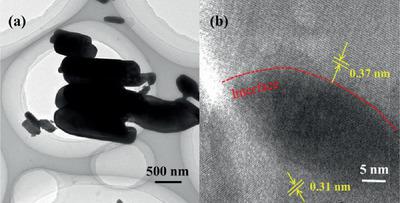当前位置:
X-MOL 学术
›
Cryst. Res. Technol.
›
论文详情
Our official English website, www.x-mol.net, welcomes your
feedback! (Note: you will need to create a separate account there.)
Constructing Z‐Scheme Bi2O3/In2O3 Heterojunction for Efficient Photocatalytic Degradation of Rhodamine B
Crystal Research and Technology ( IF 1.5 ) Pub Date : 2020-08-20 , DOI: 10.1002/crat.202000093 Hongjun Chen 1 , Zi Wang 1 , Zeyang Xue 1 , Chunhu Yu 1 , Lizhai Pei 2 , Chuangang Fan 1
Crystal Research and Technology ( IF 1.5 ) Pub Date : 2020-08-20 , DOI: 10.1002/crat.202000093 Hongjun Chen 1 , Zi Wang 1 , Zeyang Xue 1 , Chunhu Yu 1 , Lizhai Pei 2 , Chuangang Fan 1
Affiliation

|
A Bi2O3/In2O3 heterojunction is successfully fabricated via a facile hydrothermal method using sodium bismuthate and indium nitrate as the source materials. The crystal structure, composition, micromorphology, and optical property of the Bi2O3/In2O3 heterojunction are analyzed by X‐ray diffraction, X‐ray photoelectron spectroscopy, Fourier transform infrared spectrum, scanning electron microscopy, transmission electron microscopy, and solid ultraviolet‐visible (UV‐vis) diffuse reflectance spectra. The Bi2O3/In2O3 heterojunction exhibits a remarkable photocatalytic degradation capacity for Rhodamine B, which is better than that of pure Bi2O3 and In2O3. The photogenerated charges separation and transfer process of the Bi2O3/In2O3 heterojunction follows a direct Z‐scheme mechanism under UV–vis light irradiation. The trapping experiment indicates that oxidative radicals including •OH, h+, and •O2− play crucial roles in the photodegradation process. The outstanding photodegradation capacity is ascribed to spatially separated charge carriers, fast‐charge transportation characteristic, and special bandgap structure of the Bi2O3/In2O3 heterojunction. The introduction of H+ and OH− ions into the reaction system promotes the formation of •OH and •O2− radicals, significantly enhancing the photodegradation rate of RhB. This study presents a new insight into the construction of the Z‐scheme Bi2O3/In2O3 heterojunction photocatalyst with potential application in wastewater treatment.
中文翻译:

Z-方案Bi2O3 / In2O3异质结的构建以有效地降解罗丹明B
采用铋酸钠和硝酸铟为原料,通过简便的水热法成功制备了Bi 2 O 3 / In 2 O 3异质结。的晶体结构,组成,微观,和光学性能的Bi 2 ö 3 /在2 ö 3异质结是通过X射线衍射,X射线光电子能谱分析,傅里叶变换红外光谱,扫描电子显微镜,透射电子显微镜,以及固体紫外可见(UV-vis)漫反射光谱。Bi 2 O 3 / In 2 O 3异质结对罗丹明B表现出显着的光催化降解能力,优于纯Bi 2 O 3和In 2 O 3。Bi 2 O 3 / In 2 O 3异质结的光生电荷分离和转移过程遵循紫外线可见光下的直接Z方案机制。捕集实验表明,氧化基团,包括•OH,H +,并•ö 2 -在光降解过程中起关键作用。出色的光降解能力归因于Bi 2 O 3 / In 2 O 3异质结在空间上分离的电荷载流子,快速电荷传输特性和特殊的带隙结构。H的介绍+和OH -离子进入反应体系促进•OH的形成和•ö 2 -基团,显著增强罗丹明B的光降解速率。这项研究为Z方案Bi 2 O 3 / In 2 O 3的构建提供了新的见解。 异质结光催化剂在废水处理中的潜在应用。
更新日期:2020-08-20
中文翻译:

Z-方案Bi2O3 / In2O3异质结的构建以有效地降解罗丹明B
采用铋酸钠和硝酸铟为原料,通过简便的水热法成功制备了Bi 2 O 3 / In 2 O 3异质结。的晶体结构,组成,微观,和光学性能的Bi 2 ö 3 /在2 ö 3异质结是通过X射线衍射,X射线光电子能谱分析,傅里叶变换红外光谱,扫描电子显微镜,透射电子显微镜,以及固体紫外可见(UV-vis)漫反射光谱。Bi 2 O 3 / In 2 O 3异质结对罗丹明B表现出显着的光催化降解能力,优于纯Bi 2 O 3和In 2 O 3。Bi 2 O 3 / In 2 O 3异质结的光生电荷分离和转移过程遵循紫外线可见光下的直接Z方案机制。捕集实验表明,氧化基团,包括•OH,H +,并•ö 2 -在光降解过程中起关键作用。出色的光降解能力归因于Bi 2 O 3 / In 2 O 3异质结在空间上分离的电荷载流子,快速电荷传输特性和特殊的带隙结构。H的介绍+和OH -离子进入反应体系促进•OH的形成和•ö 2 -基团,显著增强罗丹明B的光降解速率。这项研究为Z方案Bi 2 O 3 / In 2 O 3的构建提供了新的见解。 异质结光催化剂在废水处理中的潜在应用。











































 京公网安备 11010802027423号
京公网安备 11010802027423号